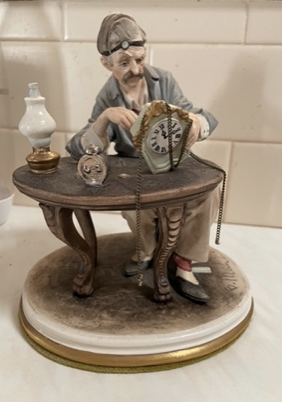The little knickknacks, trinkets, or treasured hand-me-downs in our homes make us smile, bring up memories of loved ones or precious moments, and can also take us on surprising journeys into the past.

This figurine used to sit on the mantle at my grandparents’ home. They have both now passed, and the figurine has a new home perched on a prominent shelf in my parents’ home.
For us, it is a reminder of my grandfather, a jeweller and clock repairer. It never fails to bring up memories of him whenever our eyes touch on it or a visitor mentions it.
Memories of him bringing a chocolate treat home for his daughter every Saturday after he left his shop in Northcote, Victoria; memories of him teaching his future son-in-law how to repair clocks himself; memories of rummaging through his many drawers of cogs, wheels and costume gems looking for hidden treasure. However, the figurine can also give us a glimpse into the history of porcelain.
The production of porcelain was discovered in China, and its production was coveted by those who visited China’s shores. China, however, maintained a monopoly on porcelain production by keeping the type of clay and formula a secret from any travellers who inquired about it.[1] The monopoly remained until German, Johann Friedrick Böttger accidentally discovered the formula for turning clay into porcelain during his attempts at alchemy.[2] Factories then started appearing in Europe, beginning with Meissen, Germany, with Italy getting its first factory in 1720.[3]
Upon marrying 13-year-old Princess Maria Amelia Christina, the granddaughter of the first founder of a porcelain factory in Meissen, the King of Naples, Charles VII, began experimenting with porcelain production.[4] He erected a porcelain factory on Royal Grounds in 1743 on a hill overlooking Naples. He called the pieces produced Capodimonte, which translates to “top of the mountain”.[5]
Such was their love for porcelain that the King had an entire room made of porcelain built for his queen.

The earliest pieces of Capodimonte had no markings.[6] When they did adopt a trademark, the initial one was a fleur-de-lis in honour of King Charles of Naples heritage.[7] King Charles was so enamoured with porcelain and its production that when he succeeded to the throne of Spain, he took the moulds, clay, equipment and some of the workers from the Naples factory and built a new factory in Madrid.[8] This factory was eventually destroyed through mismanagement and war. However, King Charles’s son, Ferdinand, took up the production of Capodimonte porcelain again in Naples.[9] These porcelain pieces were initially marked by a blue crown with a capital R. Then, later, a crown with a capital N underneath.[10] This is the basis for the mark shown on my family’s figurine. A mark that shows the history of its production, rather than being a value marker.[11] After Napoleon invaded Naples, Ferdinand lost interest in porcelain, and the moulds and models were sold off, ending royal involvement in Capodimonte.[12]
The Capodimonte style was reborn in 1925, however, when Signora Carozzi founded Industria Lombardo Porcellane Artistiche (ILPA).[13] Although many new artists were attracted to the business, the factory was quick to disband, and a new factory, Industria Porcellane Artistiche (IPA), took its place.[14]
The IPA continued the production of the old ornate, flowery figurine styles, but it also started to produce more realistic figures that depicted the everyday life of the Italian people.
In 1952, three artists broke away from IPA and formed their own company called Kings Porcelain.[15] One of those artists was Bruno Merli, whose signature is on my family’s figurine.[16] Merli started his own studio in 1960 in Italy, marking his pieces with a stylised crown.[17]

The understanding of the broader world we can achieve through looking at our treasured pieces is invaluable and may surprise you with the links they have to history itself.
[1] Catherine P. Bloom, Capodimonte collectibles, Publications International, Lincolnwood, IL, 1990, p 185, https://archive.org/details/capodimontecolle0000unse/page/38/mode/2up?q=b, accessed 23 November 2024.
[2] Bloom, Capodimonte collectibles, p 185.
[3] Bloom, Capodimonte collectibles, p 185; Catherine P. Bloom, Capodimonte collectibles, Publications International, Lincolnwood, IL, 1990, p 7, https://archive.org/details/capodimontecolle0000unse/page/38/mode/2up?q=b, accessed 23 November 2024.
[4] Bloom, Capodimonte collectibles, p 7; Catherine P. Bloom, Capodimonte collectibles, Publications International, Lincolnwood, IL, 1990, p 9, https://archive.org/details/capodimontecolle0000unse/page/38/mode/2up?q=b, accessed 23 November 2024.
[5] Bloom, Capodimonte collectibles, p 9.
[6] Catherine P. Bloom, Capodimonte collectibles, Publications International, Lincolnwood, IL, 1990, p 19, https://archive.org/details/capodimontecolle0000unse/page/38/mode/2up?q=b, accessed 23 November 2024.
[7] Bloom, Capodimonte collectibles, p 19.
[8] Santandrea, ‘How to Identify Real Capodimonte Porcelain’; Catherine P. Bloom, Capodimonte collectibles, Publications International, Lincolnwood, IL, 1990, p 22, https://archive.org/details/capodimontecolle0000unse/page/38/mode/2up?q=b, accessed 23 November 2024.
[9] Catherine P. Bloom, Capodimonte collectibles, Publications International, Lincolnwood, IL, 1990, p 23, https://archive.org/details/capodimontecolle0000unse/page/38/mode/2up?q=b, accessed 23 November 2024; Catherine P. Bloom, Capodimonte collectibles, Publications International, Lincolnwood, IL, 1990, p 25, https://archive.org/details/capodimontecolle0000unse/page/38/mode/2up?q=b, accessed 23 November 2024.
[10] Bloom, Capodimonte collectibles, p 25.
[11] Santandrea, ‘How to Identify Real Capodimonte Porcelain’.
[12] Catherine P. Bloom, Capodimonte collectibles, Publications International, Lincolnwood, IL, 1990, p 34, https://archive.org/details/capodimontecolle0000unse/page/38/mode/2up?q=b, accessed 23 November 2024.
[13] Catherine P. Bloom, Capodimonte collectibles, Publications International, Lincolnwood, IL, 1990, p 37, https://archive.org/details/capodimontecolle0000unse/page/38/mode/2up?q=b, accessed 23 November 2024.
[14] Catherine P. Bloom, Capodimonte collectibles, Publications International, Lincolnwood, IL, 1990, p 38, https://archive.org/details/capodimontecolle0000unse/page/38/mode/2up?q=b, accessed 23 November 2024.
[15] Bloom, Capodimonte collectibles, p 38.
[16] Bloom, Capodimonte collectibles, p 38.
[17] Bloom, Capodimonte collectibles, p 38; Worthpoint, ‘Bruno Merli of Capodimonte, Accordian Playing Tramp & Money Collecting Monkey’, webpage, n.d., https://www.worthpoint.com/worthopedia/bruno-merli-capodimonte-accordian-268340874, accessed 23 November 2024.
